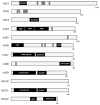snRNA 3' end formation: the dawn of the Integrator complex
- PMID: 20659008
- PMCID: PMC3969742
- DOI: 10.1042/BST0381082
snRNA 3' end formation: the dawn of the Integrator complex
Abstract
The ubiquitously expressed uridine-rich snRNAs (small nuclear RNAs) are essential for the removal of introns, proper expression of histone mRNA and biosynthesis of ribosomal RNA. Much is known about their assembly into snRNP (small nuclear ribonucleoprotein) particles and their ultimate function in the expression of other genes; however, in comparison, less is known about the biosynthesis of these critical non-coding RNAs. The sequence elements necessary for 3' end formation of snRNAs have been identified and, intriguingly, the processing of snRNAs is uniquely dependent on the snRNA promoter, indicating that co-transcriptional processing is important. However, the trans-acting RNA-processing factors that mediate snRNA processing remained elusive, hindering overall progress. Recently, the factors involved in this process were biochemically purified, and designated the Integrator complex. Since their initial discovery, Integrator proteins have been implicated not only in the production of snRNA, but also in other cellular processes that may be independent of snRNA biogenesis. In the present study, we discuss snRNA biosynthesis and the roles of Integrator proteins. We compare models of 3' end formation for different classes of RNA polymerase II transcripts and formulate/propose a model of Integrator function in snRNA biogenesis.
Figures


Similar articles
-
Evolutionarily divergent spliceosomal snRNAs and a conserved non-coding RNA processing motif in Giardia lamblia.Nucleic Acids Res. 2012 Nov;40(21):10995-1008. doi: 10.1093/nar/gks887. Epub 2012 Sep 27. Nucleic Acids Res. 2012. PMID: 23019220 Free PMC article.
-
A subset of Drosophila integrator proteins is essential for efficient U7 snRNA and spliceosomal snRNA 3'-end formation.Mol Cell Biol. 2011 Jan;31(2):328-41. doi: 10.1128/MCB.00943-10. Epub 2010 Nov 15. Mol Cell Biol. 2011. PMID: 21078872 Free PMC article.
-
The host Integrator complex acts in transcription-independent maturation of herpesvirus microRNA 3' ends.Genes Dev. 2015 Jul 15;29(14):1552-64. doi: 10.1101/gad.266973.115. Genes Dev. 2015. PMID: 26220997 Free PMC article.
-
Regulation of expression of human RNA polymerase II-transcribed snRNA genes.Open Biol. 2017 Jun;7(6):170073. doi: 10.1098/rsob.170073. Open Biol. 2017. PMID: 28615474 Free PMC article. Review.
-
E Pluribus Unum: 3' end formation of polyadenylated mRNAs, histone mRNAs, and U snRNAs.Mol Cell. 2005 Oct 28;20(2):168-70. doi: 10.1016/j.molcel.2005.10.009. Mol Cell. 2005. PMID: 16246719 Review.
Cited by
-
The 3' Pol II pausing at replication-dependent histone genes is regulated by Mediator through Cajal bodies' association with histone locus bodies.Nat Commun. 2022 May 25;13(1):2905. doi: 10.1038/s41467-022-30632-w. Nat Commun. 2022. PMID: 35614107 Free PMC article.
-
Good cap/bad cap: how the cap-binding complex determines RNA fate.Nat Struct Mol Biol. 2014 Jan;21(1):9-12. doi: 10.1038/nsmb.2751. Nat Struct Mol Biol. 2014. PMID: 24389545 No abstract available.
-
RNA processing errors triggered by cadmium and integrator complex disruption are signals for environmental stress.BMC Biol. 2019 Jul 16;17(1):56. doi: 10.1186/s12915-019-0675-z. BMC Biol. 2019. PMID: 31311534 Free PMC article.
-
Plant snRNP Biogenesis: A Perspective from the Nucleolus and Cajal Bodies.Front Plant Sci. 2018 Jan 4;8:2184. doi: 10.3389/fpls.2017.02184. eCollection 2017. Front Plant Sci. 2018. PMID: 29354141 Free PMC article. Review.
-
Cajal bodies are linked to genome conformation.Nat Commun. 2016 Mar 21;7:10966. doi: 10.1038/ncomms10966. Nat Commun. 2016. PMID: 26997247 Free PMC article.
References
-
- Hernandez N. Small nuclear RNA genes: a model system to study fundamental mechanisms of transcription. J Biol Chem. 2001;276:26733–26736. - PubMed
-
- Carbon P, Murgo S, Ebel JP, Krol A, Tebb G, Mattaj LW. A common octamer motif binding protein is involved in the transcription of U6 snRNA by RNA polymerase III and U2 snRNA by RNA polymerase II. Cell. 1987;51:71–79. - PubMed
Publication types
MeSH terms
Substances
Grants and funding
LinkOut - more resources
Full Text Sources

